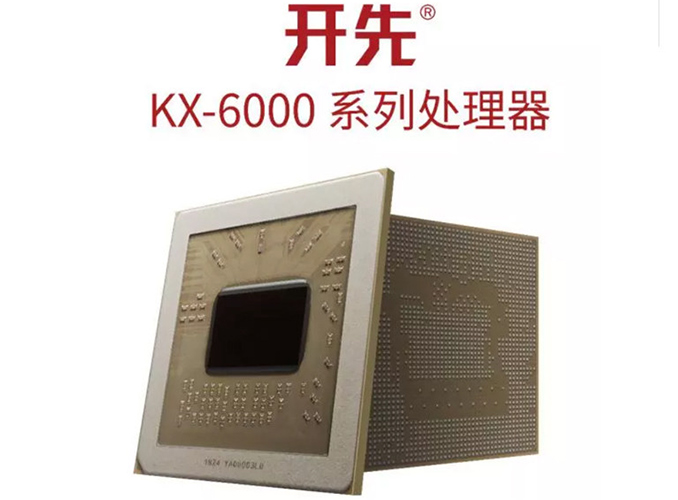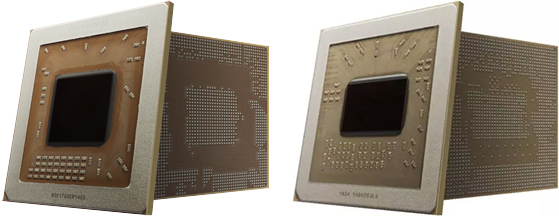Zhaoxin Displays x86-Compatible KaiXian KX-6000: 8 Cores, 3 GHz, 16 nm FinFET
by Anton Shilov on September 24, 2018 12:00 PM EST
Zhaoxin, a joint venture between Via Technologies and the Chinese government, this week for the first time displayed its upcoming x86-compatible CPU, the KaiXian KX-6000. The SoC features eight cores running at 3 GHz and increases performance over its predecessor by at least 50%.
The KaiXian KX-6000 is a successor to the KX-5000 CPU launched earlier this year. Both chips integrate eight-core x86-64 cores with 8 MB of L2 cache, a DirectX 11.1-capable iGPU with an up-to-date display controller, a dual-channel DDR4-3200 memory controller, contemporary I/O interfaces (PCIe, SATA, USB, etc), and so on. The key differences between the KaiXian KX-5000 and the KaiXian KX-6000 are frequencies and manufacturing technology: the former is produced using TSMC’s 28 nm fabrication process and runs at up to 2 GHz, whereas the latter is made using TSMC’s 16 nm technology and operates at up to 3 GHz. Zhaoxin claims that the Kaixian KX-6000 offers compute performance comparable to that of Intel’s 7th Generation Core i5 processor, which is a quad-core non-Hyper-Threaded CPU. Obviously, performance claims like that have to be verified, yet a 50% performance bump over the direct predecessor already seems beefy enough.
As the picture below shows, the thinner manufacturing process enabled Zhaoxin to make the KaiXian KX-6000 die smaller when compared to the predecessor, which will eventually shrink its manufacturing cost. Meanwhile, the two processors use different HFCBGA packaging and therefore cannot use the same motherboards. Meanwhile it is unknown whether the new KaiXian KX-6000 is compatible with Zhaoxin’s USB 3.1 Gen 2-capable ZX-200 chipset.
The Zhaoxin KaiXian KX-6000 relies on the LuJiaZui microarchitecture, which is an evolution of the WuDaoKou microarchitecture that powers the KX-5000 processor introduced in early 2018. Based on what we know today, the LuJiaZui is an x86-64-compatible superscalar, multi-issue, out-of-order microarchitecture that supports contemporary instruction sets extensions like SSE 4.2 and AVX along with virtualization and encryption technologies. Zhaoxin has yet to disclose differences between its LuJiaZui and WuDaoKou designs. Therefore, all we can do is speculate that since the microarchitectures are launched within one year from each other they are very similar, but the newer one has minor optimizations that, perhaps, enable higher clocks, improved caching, better memory support, etc.
Zhaoxin has not announced when it plans to start commercial shipments of its KaiXian KX-6000 processors, as right now it only displays its picture (which proves that it exists). Based on the previously published roadmap, we'd expect the CPU to hit the market in 2019, though when exactly is anyone's guess.
| Zhaoxin's Kaixian KX-5000 and KX-6000 CPUs | |||
| Kaixian KX-5000 WuDaoKou |
Kaixian KX-6000 LuJiaZui |
||
| Core Count | 4 - 8 | Up to 8 | |
| L2 Cache | 8 MB | 8 MB | |
| Frequency | Up to 2 GHz | Up to 3 GHz | |
| ISA | x86-64 | ||
| ISA Extensions | SSE 4.2, AVX | ? | |
| APIC | Yes | ||
| Virtualization | VMX technology, compatible with Intel's VT-X | ||
| Temperature monitoring, overheat protection | Yes | ||
| Power States | C1, C2, C3, C4, P-State | ? | |
| Hardware Encryption Engines | Advanced encryption engine (ACE), SHA-1, SHA-256, SM3/SM4, Randomizer | ? | |
| Security | TXT, EDB | ? | |
| iGPU | DirectX 11.1 feature set. Hardware-accelerated video encoding/decoding. Outputs: DP, eDP, HDMI, D-Sub Max Resolution: 4K Number of Displays: 3 |
? | |
| Packaging | x-ball HFCBGA 37.5 x 37.5 mm |
y-ball HFCBGA 37.5 x 37.5 mm |
|
| Process Technology | TSMC 28 nm | TSMC 16 nm FinFET | |
Related Reading:
- Cypress and Zhaoxin Have USB 3.1 Gen 2 USB Controllers
- China Calling: AMD Forms Joint Venture for x86 Server SoCs in China
- AMD Creates Quad Core Zen SoC with 24 Vega CUs for Chinese Consoles
Source: PC Watch











77 Comments
View All Comments
HStewart - Monday, September 24, 2018 - link
Intel was working on 64 bit - at time that AMD came out with it. Most important the original architecture was created by Intel. Upping to 64 bit at the time was seen not a big deal - just adding extra bits to original implementation.CaedenV - Monday, September 24, 2018 - link
lol, Intel's implementation was terrible though. They just finally stopped supporting those Itanium chips last year I think.rocky12345 - Monday, September 24, 2018 - link
Yes Intel was but not for the Desktop sector they had or were doing IA-64 which was totally different. It was AMD that that came up with AMD64 and a bit later on Intel decided to use that. Maybe Intel was working on 64 bit as well but they were most likely trying to adapt the IA-64 into an x86 CPU which would have pretty much screwed AMD over because you know Intel would not have licensed that to AMD and then AMD would have done their AMD64 and we would have had AMD64 & IA-64 on the market and it would have become a cluster frack for software dev's so I am glad AMD got there first and we now have a single 64 bit instruction setup and not 2 for the desktop.29a - Tuesday, September 25, 2018 - link
"cluster frack"Does this website censor comments?
Lord of the Bored - Monday, September 24, 2018 - link
AMD64 is actually a new processor mode. It is not just "protected mode, but with wider registers". And long mode behaves quite differently than protected mode, much as protected mode behaves quite differently than real mode.Anyways, it doesn't matter if it is added on to something else or not. It is still AMD's creation, and AMD holds the rights to their additions. That IS how the law works. Since APPARENTLY you can have a copyright on a frickin' microprocessor instruction set these days. I hate the world.
And Intel's 64-bit solution was a nonstarter. They created an entirely new processor architecture, and saw no reason anyone would want 64-bit x86 parts. They had no hand in extending x86, and I'm pretty sure that licensing an outsider's extensions sticks in their craw to this day. But that's what circumstances were at the time. AMD64 was a HUGE deal, and Intel was in no position to ignore it.
...
Honestly, where do you get the idea that "Upping to 64 bit at the time was seen not a big deal"? Sledgehammer lit the world on fire, and those first Opterons attracted quite a bit of attention.
Zoolook - Wednesday, September 26, 2018 - link
It could be argued that the original archiecture was created by CTC, for the 8008, Intel expanded and rewrote it for the 8080.wumpus - Thursday, September 27, 2018 - link
8086/8088 does not maintain binary compatibility with 8080, so really isn't part of the architecture. 8086 was designed to be *assembly* language compatible, so for every 8080 opcode there existed a compatible 8088 opcode, but the exact binaries needed to be reassembled and linked.If this was *perfectly* exact, presumably you could simply binary translate binaries, but I doubt all the opcodes had exactly the same size and you probably had to massage the assembly source if you were picky enough about where your memory was (and when 8088 was designed, everybody *cared* about every last byte: they were expensive). But still, not needed to rewrite *assembler* completely was unheard of, and good enough in those days.
HStewart - Monday, September 24, 2018 - link
Intel and AMD do have differences in 64 bit implementation Intel is called EMT64 and is different than AMD64https://superuser.com/questions/383711/whats-the-d...
I saw some blubber about AMD should end license - I think out of mess - Intel and AMD - just agree that AMD can use the original architecture including name of functions and such and to satisfied Microsoft Intel will support 64 bit extensions ( this is important part - 64 bit extensions ).
MamiyaOtaru - Tuesday, September 25, 2018 - link
yeah awesome. "extended Memory 64-bit Technology (EM64T) is Intel‘s implementation of AMD‘s AMD64" with this as a reference: https://en.wikipedia.org/wiki/X86-64#Intel_64 It lists the minor differences but it's made super obvious there that Intel licensed the base tech from AMD. "Historically, AMD has developed and produced processors with instruction sets patterned after Intel's original designs, but with x86-64, roles were reversed: Intel found itself in the position of adopting the ISA which AMD had created as an extension to Intel's own x86 processor line." etc.You either don't know WTF you are talking about, or this is a gross attempt at gaslighting
Manch - Tuesday, September 25, 2018 - link
I see you've met HStewart the Intel shill extraordinaire. LOL